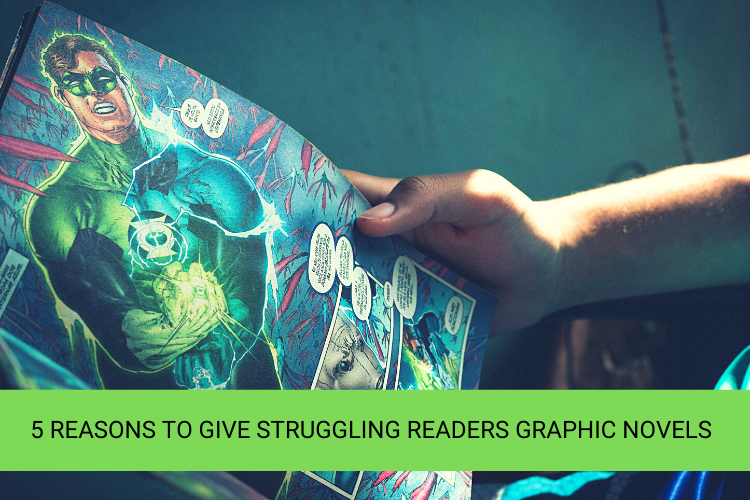In this second guest post in a series of six by Margo L. Dill, M.A. Ed., author and publisher, Margo explains the benefits of graphic novels. Take it away, Margo!
When my stepson was in upper elementary and middle school, he struggled with reading, but he loved to go to the library and to check out graphic novels. It was the section he was drawn to in the bookstores, too. Was I disappointed or encouraging him to try “real” novels or chapter books? Nope! I told him to check out whatever held his interest and was a book.
As I discussed in my previous post about audio books, graphic novels are just as real and important for developing readers as traditional chapter books and middle-grade novels. Here are five reasons why it’s a good idea to consider graphic novels for struggling readers:
Reason one: Illustrations help comprehension.
Just like with picture books, young readers can use the illustrations in a graphic novel to help them understand the story and even decipher text. Our goal for young readers, no matter what format they are reading, is for them to comprehend the content and make connections with other material they’ve read or watched or in their own lives.
If a beloved superhero character in a graphic novel is tracking the evil villain, and there are illustrations to help the reader figure out what the characters are saying or doing, then that’s terrific—and it’s often the case in graphic novels (or any book with illustrations). But the other great thing about graphic novels is the child does not have to be the best reader to understand the story because the illustrations help tell the story. So young readers can work on comprehension skills and learn story structure with a graphic novel, just like they do with a print book.
Reason two: Graphic novels are less overwhelming.
For struggling readers (or even a child who reads at grade level but doesn’t love to read), graphic novels can be a way for them to enjoy books and stories without feeling overwhelmed. If you give a struggling or reluctant reader a 200-page traditional children’s novel, they will most likely flip through it, see all the words covering the pages, and give up before they even get started. But because so many graphic novels look like comic books and are a bridge between picture books and novels, children won’t feel so overwhelmed by the number of pages or words.

Reason three: Graphic novels contain age-appropriate content.
Struggling readers can feel very frustrated when they can’t read content that they’re interested in. Age-appropriate content is often too difficult for their personal reading level. Although graphic novels may use sophisticated vocabulary when the characters speak or transitions between scenes, the reader is able to easily follow along because of the illustrations that help to tell the story.
It’s no secret that struggling readers are often reluctant readers because the books they’re able to read feel too young for them. A fourth grader does not want to read an Amelia Bedelia book, for example. But give him a graphic novel with his favorite superhero characters that he can read and understand (due to the limited text and many illustrations), and he will be much more into the book.
Reason four: Allow struggling readers to develop a love of story.
One complaint teachers and parents often hear from struggling readers is that they hate reading. Other children may state that reading is boring and/or “dumb.” These aren’t just excuses because they don’t want to read. Think about it: if you spent most of your time with a book deciphering every word and struggling over the meaning, you might have similar complaints. Graphic novels can help reluctant and struggling readers develop a love for storytelling and reading.
As previously mentioned, my stepson was drawn to graphic novels, and he even asked for them for gifts. He wanted to read the next books in some of the graphic novel series, and he was invested in the characters. Graphic novels allowed him to be excited about books, and now ten years later as a young adult, he is still choosing to read books—and now his choice is often novels, like the Harry Potter series.
Reason five: Graphic novels can improve self-esteem.
As teachers and parents, we know that struggling readers often use avoidance techniques, so they don’t have to face embarrassing situations around reading—such as reading aloud or showing classmates what lower reading level book they are reading during independent reading time. But being able to get out the latest graphic novel or being able to finish it and talk about it with other kids can help children who don’t read at grade level to feel success in reading, which improves self-esteem.
If your child is drawn to graphic novels, then give them a try. They are available at libraries, bookstores, and many of the school book fairs, too. Who knows? Even you might become a fan of a series and find yourself anxiously awaiting the next installment of a graphic novel soon!




Comments ()